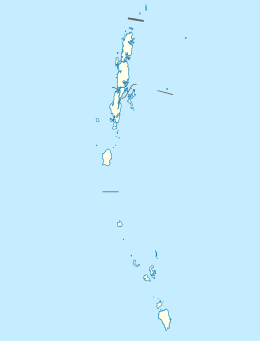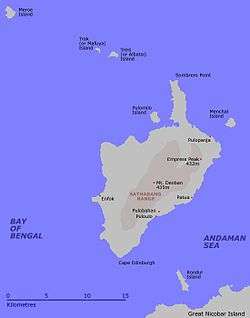Pulomilo
Pulomilo is an island in the Nicobar district of Andaman and Nicobar Islands, India, and home to a village of the same name. It is located just north of Little Nicobar Island,
| Native name: Pilomillow, Pulo Milo | |
|---|---|
 Pulomilo Location of Pulomilo Island in the Andaman and Nicobar Islands | |
| Geography | |
| Location | Bay of Bengal |
| Coordinates | 7.4°N 93.69°E |
| Archipelago | Nicobar Islands |
| Adjacent bodies of water | Indian Ocean |
| Total islands | 1 |
| Major islands |
|
| Area | 0.82 km2 (0.32 sq mi)[1] |
| Length | 1.3 km (0.81 mi) |
| Width | 0.9 km (0.56 mi) |
| Coastline | 4.8 km (2.98 mi) |
| Highest elevation | 10 m (30 ft) |
| Administration | |
| District | Nicobar |
| Island group | Nicobar Islands |
| Subdivisions of India | Great Nicobar Subdivision |
| Taluk | Little Nicobar |
| Largest settlement | Pulomilo (pop. 20) |
| Demographics | |
| Population | 20 (2014) |
| Pop. density | 0/km2 (0/sq mi) |
| Ethnic groups | Hindu, Nicobarese |
| Additional information | |
| Time zone | |
| PIN | 744301 |
| Area code(s) | 03192 |
| ISO code | IN-AN-00[2] |
| Official website | www |
| Literacy | 82.35% |
| Avg. summer temperature | 32.0 °C (89.6 °F) |
| Avg. winter temperature | 28.0 °C (82.4 °F) |
| Sex ratio | ♂/♀ |
| Census code | 35.638.0002.645140 |
| Official Languages | Hindi, English, Tamil Car (regional) |
History
Impact of 2004 earthquake and tsunami
Pulomilo was devastated by the 2004 Indian Ocean earthquake and tsunami. There were initial fears that the entire population had been drowned,[3] but later reports showed that the island had been evacuated.[4][5][6]
One-hundred five people were killed by the 2004 disaster on Pulomilo, representing 49.1% of the island's population. Of the 109 survivors, 15 (13.8%) had suffered an injury severe enough to be reportable and almost half (41 individuals) experienced diarrhoea, dysentery, fever, or a respiratory infection.[7]
Besides the human losses, Pulomilo's economy and infrastructure were also devastated. Before the tsunami, Pulomilo residents enjoyed a few hours of electricity each night, and the village accommodated a small police post and radio house manned on a rotational basis.[8] The tsunami swept away most structures on the island.[7]
Not only were buildings shattered, but the tsunami also severely eroded the villagers ability to sustain themselves. It destroyed twenty-two of the islanders' outrigger canoes and eight boats,[7] leaving only two embarkations in working order,[8] and killed 823 livestock animals,[7] including 239 pigs belonging to 25 families.[9]
Geography
Pulomilo Island has a size of 0.82 km2 (0.32 sq mi). Before the 2004 Indian Ocean earthquake and tsunami, Pulomilo was connected to the Little Nicobar island. After the earthquake and tsunami, it became an island, as most of its land — except a small hilltop — was eroded or submerged.[10] Most of the island is covered in forests of casaurina, pandanus and coconut-palm. [11]
Administration
Pulomilo island belongs to the township of Great Nicobar of Little Nicobar Taluk.[12] [13]
Economics
Pulomilo island's main production crop is coconut in the form of copra.[7][14] The island has no electricity,[14] and the primary mode of transport is by boat.[7][8]
Demographics
Pulomilo Island's sole settlement is the village of Pulomilo.[14] According to the 2011 census data, Pulomilo has a total population of 20 individuals in 5 households.[7]:29, 35[14][16]
The primary language spoken among the residents is the Channai Payuh dialect of Nicobari[8][14] and most are Christians.[14] The effective literacy rate (i.e. the literacy rate of population excluding children aged 6 and below) is 82.35%.[16]
Image gallery
 Map
Map Pulomilo is located to the north-west of the Little Nicobar Island
Pulomilo is located to the north-west of the Little Nicobar Island
References
- "Islandwise Area and Population - 2011 Census" (PDF). Government of Andaman. Archived from the original (PDF) on 28 August 2017. Retrieved 7 May 2016.
- Registration Plate Numbers added to ISO Code
- Hamish McDonald (12 January 2005). "A queen leaves her shattered island realm". Retrieved 12 August 2015.
- Rajib Shaw (2006). Recovery from the Indian Ocean Tsunami Disaster. Emerald Group Publishing. p. 74. ISBN 978-1-84544-954-4.
- A. K. Sengupta, Office of WHO Representative to India (2005). "India: Weekly Tsunami Situation Report as on 24 February 2005" (PDF). World Health Organization. p. 1. Retrieved 12 August 2015.
- Ramakrishnan Korakandy (2008). Fisheries Development in India: The Political Economy of Unsustainable Development, Vol. 2. Kalpaz Publications. pp. 267–368. ISBN 81-7835-634-1.
- Dr. V.R. Rao (14 May 2007). Tsunami in South Asia: Studies of Impact on Communities of Andaman and Nicobar Islands. Allied Publishers. p. 40. ISBN 9788184241891.
- Manish Chandi (November 2006). "Rehabilitation and change in the aftermath of a tsunami. A return to Little Nicobar Island". Academia.edu. Retrieved 12 August 2015.
- S. Jeyakumar & A. Kundu. "Livestock and Poultry Germplasm of Andaman and Nicobar Islands with Special Reference to the Nicobari Pig in 'Livestock-based Livelihoods: An action programme for the Andaman and Nicobar Islands. Proceedings of the Seminar held in Port Blair, Andamans, 23-24 November 2006'" (PDF). Anthra. p. 43. Retrieved 12 August 2015.
- Rajib Shaw (2006). Recovery from the Indian Ocean Tsunami Disaster. Emerald Group Publishing. pp. 58–. ISBN 978-1-84544-954-4.
- "Tehsils" (PDF). Archived from the original (PDF) on 28 August 2017. Retrieved 7 May 2016.
- "Andaman and Nicobar Islands villages" (PDF). Land Records Information Systems Division, NIC. Archived from the original (PDF) on 4 March 2016. Retrieved 25 July 2015.
- "Pulomilo Island" (PDF). Andaman & Nicobar Administration Directorate of Economics & Statistics. 2006. Retrieved 12 August 2015.
- H. P. S. Virk (2015). Rendezvous: Forbidden Land of the 'Nicobar Islands'. Friesen Press. p. 29. ISBN 978-1460258767.
- "District Census Handbook - Andaman & Nicobar Islands" (PDF). 2011 Census of India. Directorate of Census Operations, Andaman & Nicobar Islands. Retrieved 21 July 2015.
